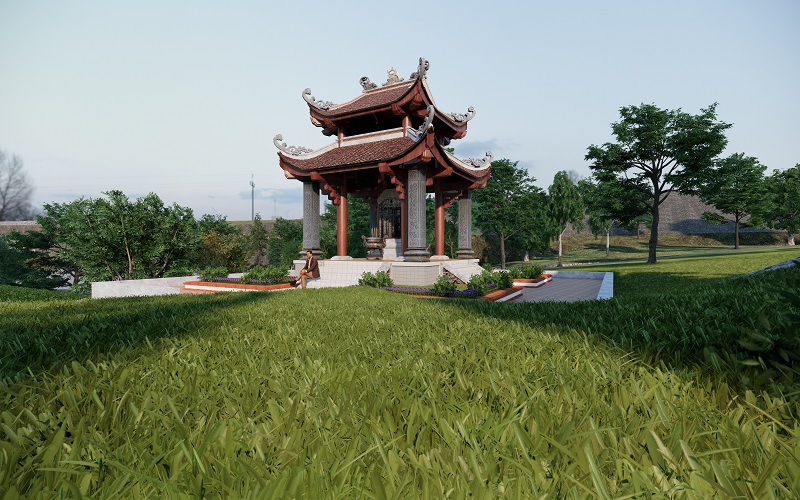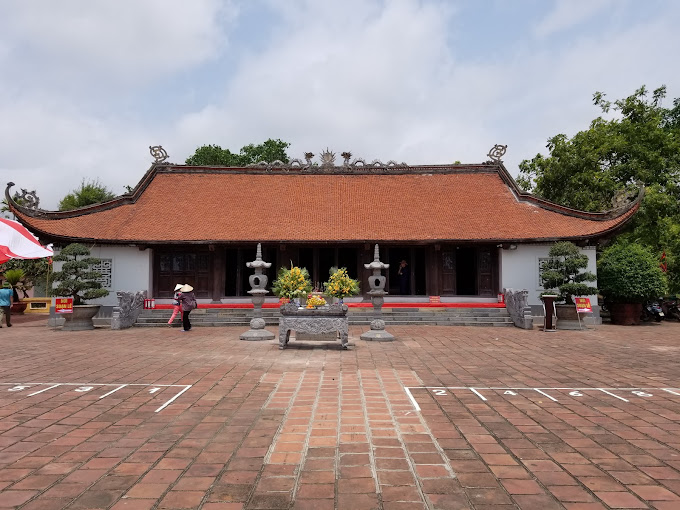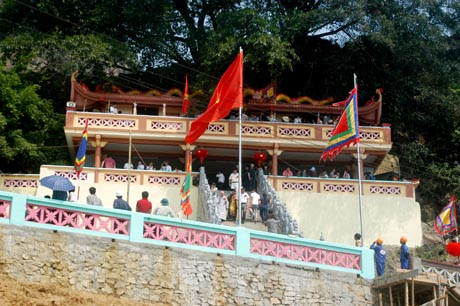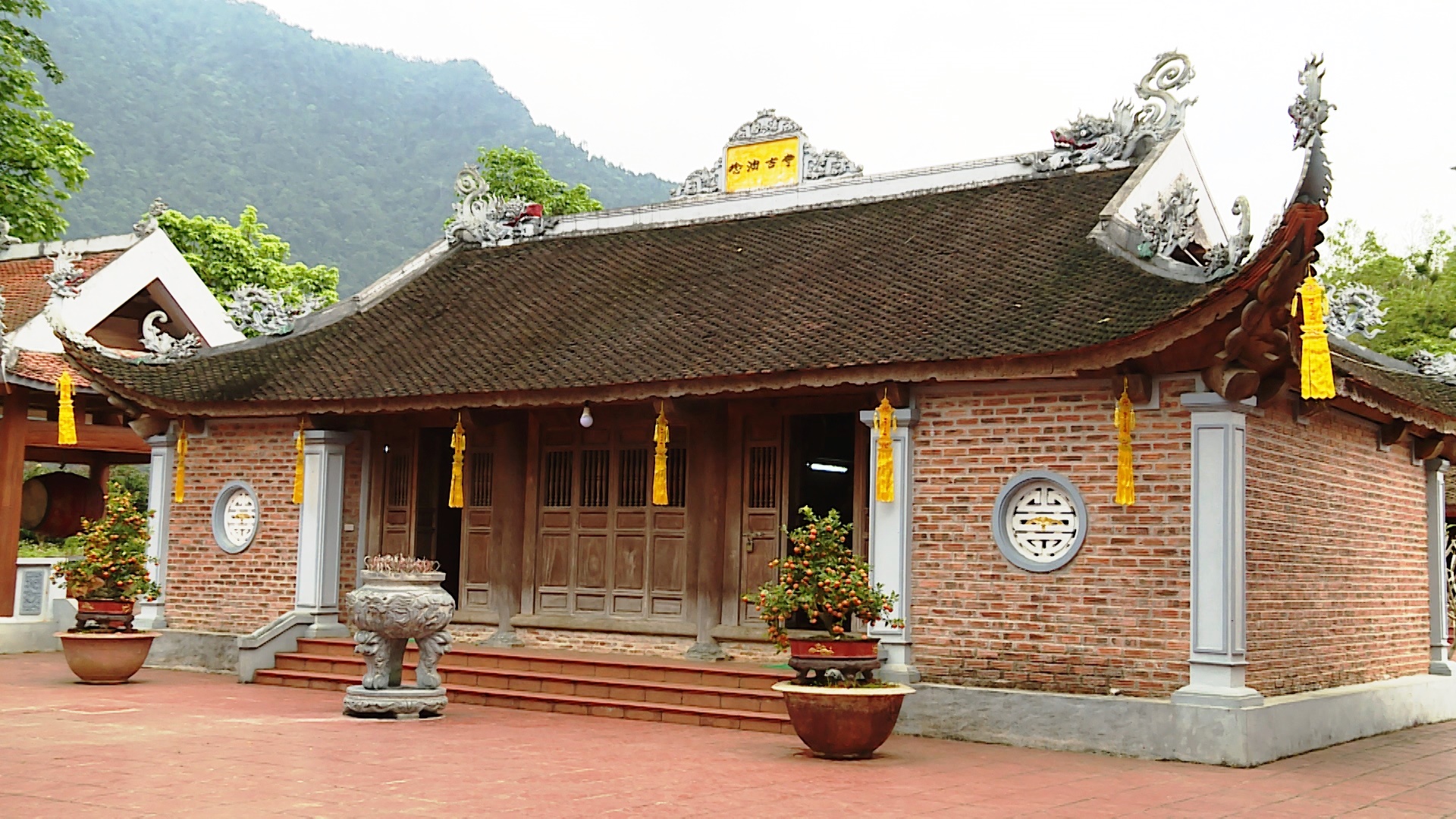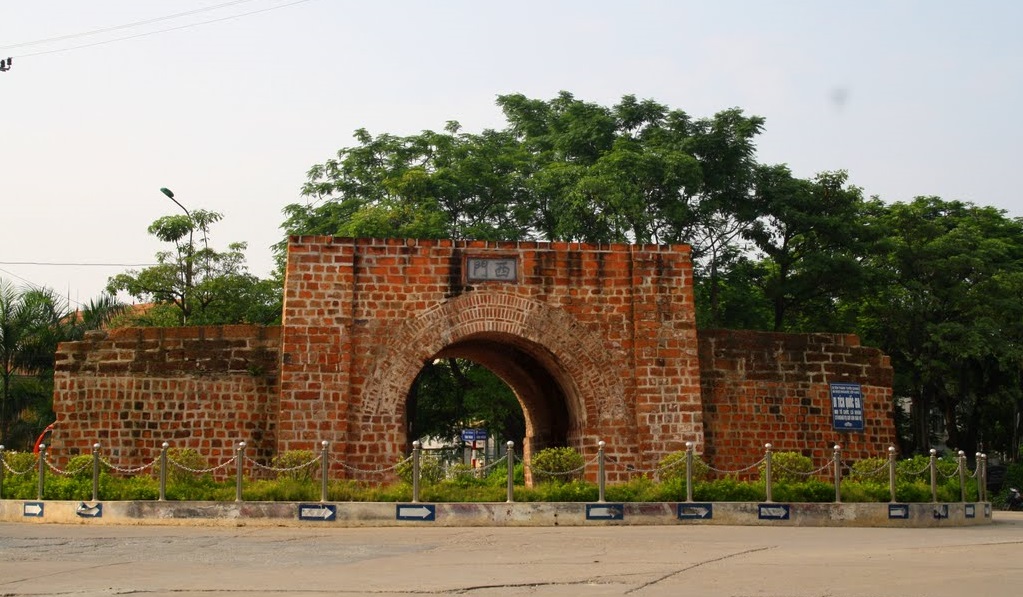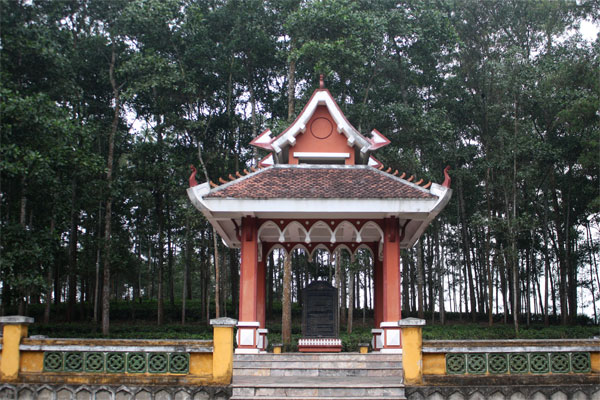Relic point Vietnam
Việt NamSTONE CELEBRATING THE PLACE OF ESTABLISHMENT OF THE WOMEN'S ADVOCACY COMMITTEE OF HA GIANG PROVINCE
STONE CELEBRATING THE PLACE OF ESTABLISHMENT OF THE WOMEN'S ADVOCACY COMMITTEE OF HA GIANG PROVINCE - Location: Bo Loong village, Hung An commune, Bac Quang district, Ha Giang province. - Directions: Commemorative stele where the Women's Mobilization Committee of Ha Giang province was founded, 70km south of Ha Giang city center, from Ha Giang city follow National Highway No. 2 towards Ha Giang - Tuyen Quang, to Market No. 9, Hung An commune, turn left along the road to Bo Loong village for more than 2km to reach the Beer location. In March 1943, Viet Minh cadres from the north of Tuyen Quang province went to Bo Loong village, Hung An commune, Bac Quang district, Ha Giang province to propagate the revolutionary line of the Viet Minh front and build a base. local revolution. Here, the Women's Advocacy Committee was established with 5 members. After its establishment, under the direction of Viet Minh cadres, the women propagated and mobilized women in Hung An commune and neighboring localities to join the Women's Union for National Salvation and participate in the revolutionary movement. Actively contributing to the revolutionary struggle to expel the enemy, gain power, and liberate the homeland and the country. The establishment of the Women's Mobilization Committee in Bo Loong village, Hung An commune - is the first grassroots organization of the Association, marking the development of the women's activist movement, which is also the premise for the year 1945: Ha Giang Province Women's Association for National Salvation was established (later Ha Giang Province Women's Union). The construction of a commemorative stele where the Women's Mobilization Committee of Ha Giang province was established in Bo Loong village, Hung An commune is to remember the place where the first grassroots organization of the women's activist movement was established, and has educational purposes. Traditional education about the traditions of patriotism, fighting against invaders to protect the country for young generations to follow, thereby constantly learning and cultivating to be worthy of previous generations, contributing to protecting and protecting the country. Build a country that is increasingly rich in beauty and culture bright. SOURCE: ELECTRONIC INFORMATION PAGE OF BAC QUANG DISTRICT, HA GIANG PROVINCE
Tuyen Quang 2740 view
Lady Temple
Chua Ba Temple does not have stone stele and related documents and papers recording the year of the temple's original construction as well as the process of formation and development. However, through the process of learning through the stories of local elderly people and some related documents collected, it can be determined as follows: Chua Ba Temple has existed in Vinh Tuy town for a long time, at that time the surrounding temple area was still desolate and deserted. The temple is built of simple, simple bamboo and leaves. The main altar holds a statue of the Lady, also known as Saint Mother Lieu Hanh[8]. Currently at the temple there are three stone stele: One stele is covered by banyan tree roots, making it impossible to read and stamp the words; A stele's letters are too faded to be read; There is only one stele left that records the year of merit entering the temple, which is 1947. Through transcription and translation, it can be seen that the content of the stele records the names of those who contributed to donating to build the temple, thereby confirming The temple was built before 1947. During the research process of Ha Giang Provincial Museum to serve the work of building relic records, it has collected from National Archives Center I and National Archives Center III a number of relevant documents that can be collected. determine the time to build the temple in Vinh Tuy town, there are a number of French dispatches in 1931 written about donations from the people to build a temple in Vinh Tuy town, Bac Quang district, province Ha Giang. Thereby, it can be determined that the time of rebuilding the temple was around 1931. Through research and collected documents, it can be seen that Chua Ba Temple had the introduction of Mother Goddess worship from the lowlands, through merchants in the process of doing business on the river, they brought their feet with them. incense to worship at Chua Ba temple. At present, the year of the temple's origin is unknown. However, based on the period when lowland residents came to Ha Giang to trade and start a business, it can be said that Chua Ba Temple was established in the early twentieth century, 1931 was just the year of donations from the people to build it. back to the temple, not the year the temple was originally built. Over the course of history, the Temple has been restored many times, the most restored and repaired times were in 1982 and 2006, thanks to the merits of local people and tourists from all over, forming the current state. Since being recognized as a provincial-level historical and cultural relic, Chua Ba Temple has been directed and directed by all levels and sectors and directly managed, planned and protected by the People's Committee of Vinh Tuy town. and promote value. Vinh Tuy Town People's Committee has issued a Decision to establish the Temple Management Board and develop internal rules and operating regulations. The functional branches have surveyed, determined the boundaries and zoned into 2 relic protection areas with a total area of 710m2 (area I is 295m2, area II is 415m2) to ensure that the relic area is not encroached. occupy, invade and influence. Lady Temple has been restored, repaired and embellished many times since its construction until now, in which 1982 and 2006 were completely restored with funds from local people and visitors. Currently, the facilities are still in good use and are regularly repaired to meet the needs of people's religious and spiritual activities. 6. Value of ranked monuments and ranking time The cultural and historical relic "THE TEMPLE OF GOD" is ranked as a provincial cultural and historical relic according to Decision No. 244/QD-UBND dated January 29, 2011 of the People's Committee of Ha Giang province "Decision on ranking Provincial-level relics, historical and cultural relics SOURCE: ELECTRONIC INFORMATION PAGE OF BAC QUANG DISTRICT, HA GIANG PROVINCE
Tuyen Quang 3072 view
TEMPLE OF SAINT TRAN HUNG DAO
Tran Hung Dao Temple was built in Tan Tien village, Tan Quang commune, Bac Quang district, Ha Giang province. The location of the temple is shown on the map of plot number 10, plot 52 of Bac Quang district, specifically as follows: + The East side borders the residential road of Tan Tien village, with a length of 31m. + The West borders Mr. Vuong Xuan Thu's land, 34m long. + The South borders Mr. Vuong Xuan Thu's land, 32m long. + The North borders Mr. Dien Van Luc's house, 43.5m long. - Directions: From Ha Giang city, follow Highway 2 towards Ha Giang - Hanoi to Km 47, turn left along the road to Tan Tien village headquarters about 500m to Tran Hung Dao Temple. 1.3. Historical origins of formation and development: Tran Hung Dao Temple currently does not have a stone stele or other documents recording the year of construction of the temple. There are only 02 conferral documents talking about the merits of Tran Hung Dao, without recording the year of construction and historical origin of the temple. temple. Therefore, it is impossible to determine with absolute accuracy the origin of formation and development process. However, through the process of research and through the stories of local elders, Tran Hung Dao Temple was previously located in Vinh Quang village, Tan Quang commune. In 1947-1948, due to the war and the implementation of "scorched earth resistance", the Temple was forced to be destroyed, then the worship objects were moved to Nam Tuoc village, Dong Tam commune (about 3000m from the current location). At that time, whenever the rainy season occurred in Nam Tuoc village, floods often made it difficult for people to go to Temple ceremonies. Therefore, around 1948-1949, Mr. Vang Seo Cang and Do Van Doc stood up to transfer the incense bowls and tablets of Tran Hung Dao and bring them to Cam Son Temple (Temple at the foot of Cam Mountain) - the current location. From then on, people called it Tran Hung Dao Temple. Since settling here, the Temple has been restored many times, the largest restoration and repair in 2004 and 2008 thanks to the merit of local people and tourists from all over, forming the current status. now. The historical relic area "TRAN HUNG DAO TEMPLE" is ranked as a provincial historical relic according to Decision No. 243/QD-UBND, dated January 29, 2011 of the People's Committee of Ha Giang province "Decision on ranking relics". provincial level”. SOURCE: ELECTRONIC INFORMATION PAGE OF BAC QUANG DISTRICT, HA GIANG PROVINCE
Tuyen Quang 3367 view
God Emperor Temple
Than Hoang Temple in Coc Pai town has an area of nearly 4,000 square meters, built in the style of an ancient stilt house, with 3 compartments, 2 left with 2 stairs up and down; The total floor area is over 250m2, including the following items: The shrine is designed in the same style as the One Pillar Pagoda (Hanoi), poured with flat concrete, 3 gabled walls, red-tiled tiled roof, high quality. porcelain material; The Temple yard was built in 2010, cemented, 13m long, 2.5m wide, from the yard to the Temple there are 12 steps; On the upper floor, there is a statue of Quan Them, on the lower floor, there is an incense bowl to worship the local people...; Leaning against the mountain, facing south, there is a pair of beautiful stone dragons. The temple was built at a value of over 3.73 billion VND according to socialized capital, with Gia Long Co., Ltd. - the proactive unit that restored the monument - contributing 2.9 billion. This is the place to worship Mr. Hoang Van Thung, a son of the Xin Man people who publicly donated land, organized villagers to do business, and guarded the border many centuries ago... Every year, the people Organize a ceremony to commemorate Mr. Hoang Van Thung, considered the village God Emperor, on the first Dragon day of the Dragon month (3rd lunar month) with solemn folk rituals. On November 30, 2011, the Provincial People's Committee issued Decision No. 2644/QD -UBND recognizing Than Hoang Temple as a Provincial Historical-Cultural Relic. Source Ha Giang province electronic information portal.
Tuyen Quang 3386 view
Nam Dau Pagoda
Along with Binh Lam Pagoda and Sung Khanh Pagoda, Nam Dau Pagoda is gradually becoming a destination that is hard to miss for tourists and Buddhists from near and far. This is also a pagoda bearing the mark of national archaeological relics. family. Nam Dau Pagoda is located on Nam Dau hill, next to Lo river, in Nam Thanh village, Ngoc Linh commune, Vi Xuyen district. Having existed for about 600 years, it was confirmed to be present during the Tran dynasty, around the second half of the 13th and early 14th centuries. Through excavations, archaeologists have discovered many relics at Nam Dau Pagoda, some of which are only found in Thang Long Imperial Citadel, or in large and important royal buildings, including relics discovered for the first time in Vietnam and in the Northern Mountainous Border region such as: Double-sided sword heads embossed with dragon shapes of quite large size, decorated statues of dragons, carp, lovebirds, etc. spectacular. Along with the relics, the decorative architecture of the pagoda further affirms its significance and importance in having a great influence on the development of Buddhism in the border mountainous region of Ha Giang. Venerable Thich Duc Chung, Abbot of Nam Dau Pagoda, said: Nau Dau Pagoda is a pagoda that fully converges the elements of feng shui and aura. The pagoda's presence here has eliminated many consequences for the people. , avoid superstition, everyone can go to the temple to worship Buddha and chant sutras. Listening to monks and monks preach the Buddha's teachings, thereby knowing how to unite, love, support each other, aim for goodness, and develop the economy together... Completed renovation and renovation in 2007. The beauty of the pagoda is imbued with the culture of the Tran Dynasty in particular and Vietnamese Buddhism in general, created from the blend of historical, spiritual and cultural values. unique cultural and artistic value. Today, Nam Dau Pagoda plays an important role in local life while contributing to the goal of developing spiritual tourism culture in the province and district. In 2009, Nam Dau Pagoda was recognized by the Ministry of Culture, Sports and Tourism as a National Monument. Associate Professor, PhD. Duong Van Sau, Former Head of the Faculty of Tourism, Hanoi University of Culture, shared: Vietnamese feudal dynasties always emphasized preserving the territory, and knew how to use spiritual and religious tools. religion and belief to protect the territory of the Fatherland. Blend with local religion to develop together. It can be said that this has been and will become one of the bright spiritual and cultural destinations of Vi Xuyen tourism. And this is the right direction of Ha Giang province in general and Vi Xuyen district in particular in terms of tourism development in the coming time... Located in the ancient pagoda system of Vi Xuyen district, Ha Giang province, with unique values, Nam Dau Pagoda not only creates a unique relic area, suggesting to generations many things about the history of a region. border land but also attracts a large number of tourists from all over to make pilgrimages and visit scenic spots, becoming a famous spiritual tourism destination of Ha Giang. Source Ha Giang province electronic information portal
Tuyen Quang 3746 view
Mac Dynasty Citadel Relics (Tuyen Quang Citadel)
Tuyen Quang Citadel (also known as Mac Dynasty Citadel) is located between Xuan Hoa and Tam Co neighborhoods, in Tan Quang ward, Tuyen Quang city, built around 1533-1548. The citadel was built in a square shape, each side is 275m long, the wall is 3.5m high, and the thickness at the top of the citadel is 0.8m. In the middle of each side of the citadel there is a semicircular door opening to the four directions east, west, south, and north. A tower was built above the door and the roof was covered with scale tiles. Inside the citadel wall, there is a small path for refueling ammunition, first aid, and transporting wounded. Bricks are made of laterite containing iron ore, which is very hard. At the outer edge of the citadel is a layer of deep, flooded moats. At the beginning of the Nguyen Dynasty, the citadel was repaired, reinforced, and built with small bricks. In the citadel, slightly to the north, there is Tho Son mountain, nearly 50m high, steep, very convenient for observing and defending when surrounded. Located on the banks of the Lo River, located on a convenient transportation axis, the terrain and structure make the citadel an important military position. There were many historical events that took place in the Mac Dynasty citadel: In 1884, ethnic people led by Lanh Chan and Doc Thinh along with Luu Vinh Phuc's army besieged the French army in the citadel from August 1884 to April 1885, blocking supply ships and digging many tunnel, use explosives to destroy it. Out of a total of 600 enemies, 200 were killed and more than 300 were injured. At dawn on August 17, 1945, under the command of the Provincial Uprising Committee, the Liberation Army and local self-defense quickly captured the provincial governor's palace, security camp, post office, and treasury department, leaving only Tuyen Quang citadel was camped by Japanese troops. On August 20, the Liberation Army both blocked the Japanese army from Ha Giang and concentrated its forces to attack the citadel, organizing a mass march to show its might. On August 21, the Japanese army was forced to surrender. On March 20, 1961, at the stadium at the foot of Tho Son mountain, Tuyen Quang people held a meeting to welcome President Ho Chi Minh to visit and work. Tuyen Quang Citadel Relics was ranked as a National Relic on August 30, 1991. Source: Tuyen Quang Electronic Newspaper
Tuyen Quang 3980 view
Binh Lam Pagoda, Binh Lam Pagoda Bell are National Treasures
Binh Lam Pagoda is 15km from the center of Ha Giang city, located in Muong Nam village, Phu Linh commune, Vi Xuyen district, where the National Treasure of Binh Lam Pagoda Bell is kept. In the history of our country, during the Ly - Tran dynasties, Buddhism was popular, pagodas were built everywhere, far away from the capital Thang Long, in Ha Giang land there were also a number of pagodas, including Binh Lam pagoda. . The bell was minted by leader Nguyen Anh - the local leader along with his wife and old men, women, good men and women, at the hour of the Horse, the full moon day of the third month of the year At Mui (1295) and kept. from then until now. On the body of the bell there are 3 large Chinese characters "Phung Tam Bao" meaning worshiping the Tam Bao (worshiping the Buddha temple). The bell of Binh Lam pagoda was cast in the year of the Goat (1295) during the Tran dynasty, during the reign of King Tran Anh Tong. Size: Mouth diameter: 59cm; Height: 101cm, weight 193kg. This is one of the earliest known bells in Vietnam. The handle of the bell is embossed with a pair of dragons fighting back to back, each dragon has 2 legs, each leg has 4 sharp claws clasped tightly to the top of the bell. The dragon's body is fat, strong, curved to form a bell knob, and the top of the bell handle is decorated with a lotus bud with carp scales covering the entire dragon's body. The bell body is decorated with 6 knobs arranged in 2 floors, the first floor below the base of the bell has 2 symmetrical knobs 78cm apart. The second floor has 4 knobs forming 2 symmetrical pairs through the central axis of the bell body, these knobs are 39cm apart. The round bell knobs are equally embossed, 6cm in diameter. The border around each knob has 13 regular lotus petals. The bell body is divided into 2 parts: 4 rectangular cells at the top and 4 rectangular cells at the bottom. Between the vertical rectangular boxes are 5 raised ridges running parallel to each other from top to bottom. Perpendicular to the 5 embossed ridges running along the body of this bell, on the top, between the body and the base of the bell are embossed ridges that also run parallel to each other in combination with the vertical ridges to form rectangular cells on the bell body. These rectangular boxes are surrounded by embossed moldings that are very elegant and strong. Inside the 4 rectangular boxes above are engraved cards containing 309 Chinese characters; The 4 rectangles at the bottom are plain, without any patterns or characters. The rim of the bell mouth is flared, decorated with 45 large lotus petals mixed with 45 small lotus petals all of equal size, creating a bell base that is both solid and soft but still carries a heavy Buddhist meaning through imagery. lotus. It can be said that the bell of Binh Lam pagoda is a unique original artifact that is still relatively intact. This is a Tran Dynasty bell, one of the earliest known bells in Vietnam and a rare antique in our country in general and in Ha Giang in particular. This is a large-sized Dai Hong, cast in one piece of good bronze material, creating a lively, resonant sound. The elegant shape with harmonious and balanced arrangement of compartments, especially the decorative patterns with unique and sophisticated carvings, are typical characteristics of the decorative art of the Tran Dynasty. saw that our ancestors' bell casting skills had reached their peak. The poem on the bell is an original document of the Tran Dynasty, through which we learn about the respectful attitude of the mountainous local people towards the 5th Tran King (Tran Anh Tong). Through leader Nguyen Anh - who on behalf of the royal court governed a locality "very devoted to Buddhism, spent money to build pagodas and cast bells", we see that the Tran Dynasty used Buddhism as a tool to Consolidate the great national unity bloc in response to the demands of protecting the country and fighting foreign invaders. The inscription's content further confirms the wide application of the bell in the Three Teachings, demonstrating a cultural fusion of the three religions: Confucianism, Buddhism, and Taoism of the Tran Dynasty. In 2013, the bell of Binh Lam Pagoda was recognized as a National Treasure. Source: Ha Giang Provincial Party Committee Propaganda Department
Tuyen Quang 3645 view
Khe Lau Victory Relics
Khe Lau is the intersection of Gam River and Lo River in Thang Quan commune, Yen Son district, Tuyen Quang province. This place also has many other names such as Luong junction, Cua Song or Hon Lau. With the rugged terrain, both banks of the river have dense reed hills and being near the foot of the mountain created favorable conditions for our troops to ambush and attack the enemy. From November 3, 1947, French troops began to withdraw from Champa to Tuyen Quang town by both waterway and road. The soldiers of Regiment 112 cut through the forest and crossed back to Yen Nguyen to coordinate with local militia and guerrillas to set up an ambush from the foot of Ga Pass to Ca bridge. Artillery was urgently dispatched from Yen Binh to ambush enemy ships at Hon Lau. At 2:00 p.m. on November 10, 1947, the enemy's train consisting of 2 L C T and 1 canoe carrying 200 European and African soldiers from Chiem Hoa headed to Hon Lau. Our artillery continuously opened fire. Both enemy L C Ts were hit and caught fire. The enemy's canoe fled but was also hit. French soldiers ran ashore and were immediately shot and destroyed by militia and guerrillas. The battle of Khe Lau took place for more than 1 hour, our troops destroyed more than 200 enemy soldiers, sank 2 warships, and 1 canoe. The Khe Lau victory is considered one of the 10 major battles in the Viet Bac Autumn-Winter campaign in 1947. The late Lieutenant General Pham Hong Cu, former Deputy Director of the General Political Department of the Vietnam People's Army, former Political Commissar of the Binh Ca Battalion once affirmed that during the Viet Bac Fall-Winter campaign in 1947, Tuyen Quang contributed to Victory on the Lo River front in 2 battles. The first battle was the Battle of Binh Ca and the last battle was the Battle of Khe Lau. Uncle Ho said, "The enemy is strong in two pincers. If we break them, the umbrella they hold over Viet Bac will collapse into a torn umbrella." The army and people of Tuyen Quang contributed to breaking the French waterway army, contributing greatly to the Viet Bac Fall-Winter victory in 1947. Destroying the strategic intention of fighting quickly, winning quickly, forcing them to switch to fighting for a long time. to deal with us, contributing to bringing our nation's resistance to a new era. With this victory, our armed forces have grown more and more, and the Viet Bac base has become a symbol of trust and victory. Unable to carry out their plot, the French colonialists were forced to withdraw from Viet Bac. In the process of fleeing, they were blocked and attacked by our troops, consuming much of their energy. In mid-December 1947, Tuyen Quang was clear of invaders. During the Viet Bac Fall-Winter campaign of 1947, the army and people of Tuyen Quang fought 48 battles, including 30 independent battles, 18 battles in coordination with the main army, destroying 1,300 enemies, shooting and missing 10. canoes, warships, destroyed an airplane, confiscated many weapons, military equipment, and military supplies. The army and people of Tuyen Quang have successfully completed the task of draining enemy forces, contributing to protecting the safety and secrecy of Uncle Ho's residence and the headquarters of the resistance. On December 23, 1947, in Tuyen Quang town, a ceremony to celebrate the victory of Viet Bac Fall-Winter 1947 took place and was honored to be replaced by Comrade Vo Nguyen Giap - General Commander of the People's Army and Vietnam Militia and Self-Defense Force. The Government commends the merits of the soldiers and people of Viet Bac. Source: People's Newspaper
Tuyen Quang 5223 view
Da Ban historical site
Lang Ngoi - Da Ban historical relic site is a historical place known for the love of solidarity and sharing between Vietnam and Laos. The Lao revolutionary relic is located in Lang Ngoi - Da Ban village, My Bang commune, Yen Son district, Tuyen Quang province. The relics are distributed in two areas: Lang Ngoi area and Da Ban area. The Lang Ngoi area includes relics: Neo Lao Itxala Congress Hall; Comrade Kaysone Phomvihan's residence and work place; Prince Souphanuvong's residence and work; where the Lao army unit lives and works. The entire relic site is located on Go Tre hill and To hill in Lang Ngoi village, My Bang commune, Yen Son district, Tuyen Quang province. The area that has been zoned for protection is: 1,500m2. Here, on August 13, 1950, the National Congress of the Lao Resistance Front took place. More than 100 delegates attended the Congress on behalf of the people of Lao tribes. The Congress elected the Lao Resistance Government led by Prince Souphanu-vong as Prime Minister; Comrade Kaysone Phomvihan, became Minister of Defense (later General Secretary of the Lao People's Revolutionary Party) and elected the Central Executive Committee of the Free Lao Front (Neo Lao Issala) to push Strengthen the resistance against the French colonialists, gain independence and unification for Laos, and build a prosperous and happy life for the people. Through historical changes, the vestiges have been gradually eroded. In order to preserve the historical values, Tuyen Quang Department of Culture, Sports and Tourism has implemented a project to restore and embellish the relic area. Lao revolutionary national history. The project has restored the houses and offices of comrade Kaysone Phomvihane and Prince Souphanuvong; Hall house; restore and embellish the tunnel and trench system; renovate Da Ban cave entrance; renovate the overall beer house; Build a solid bridge across the stream leading to the relic site; Build a house for the Monument Management Board... To further promote the special cultural and historical values of the Lao Revolution national relic site, the Party Committee, government and people of all ethnic groups in Tuyen Quang province have well performed the task of managing and preserving preserve, conserve, embellish and effectively promote the historical values of the relic site; making the Lao revolutionary national historical relic site in Tuyen Quang truly become a symbol of special solidarity and friendship between the two Parties, States and people of Vietnam and Laos. At the same time, do a good job of educating revolutionary traditions, especially for the young generation of the two countries to continue to nurture, nurture and make the relationship between Vietnam and Laos forever close and vibrant. Source: Department of Foreign Information
Tuyen Quang 4631 view
Kim Binh relic site
The Second National Congress Relic of the Party (Kim Binh Relic Area), includes 52 points, distributed in 4 communes: Kien Dai, Kim Binh, Vinh Quang, Linh Phu, Chiem Hoa district , Tuyen Quang province. The relic site of the Second National Congress of the Party is a place that marks many important historical events of the nation, such as: The National Congress unifying the Viet Minh Front and the Lien Viet Front into the Inter-Vietnamese Front. Vietnam, People's Alliance Conference of the three countries Vietnam - Cambodia - Laos, Nguyen Ai Quoc School (predecessor of the Ho Chi Minh National Academy of Politics) opens course III, Congress of Emulating Heroes, Soldiers and Cadres the first national model. 1. Relic site of the Party Central Committee and Government's working location, Kien Dai commune. Kien Dai commune is surrounded by a system of high hills and mountains (accounting for 3/4 of the area), the terrain is extremely dangerous, mobile, "convenient to advance, convenient to retreat", is the border area between Tuyen Quang and Bac Kan provinces. . Transportation is mainly by trails and railways (dating back to the French colonial period). Kien Dai base area is covered with a rich and diverse layer of vegetation, convenient for exploitation and construction of camps, houses, warehouses, trenches, and fortifications. Many high mountains surround villages and hamlets, forming a solid wall. There are many caves and caves in the mountain, very convenient for taking shelter when there is an alarm. The people here are mostly Tay and Dao ethnic people, with a spirit of patriotism and early revolutionary enlightenment. With a location that ensures safety, secrecy, and convenient transportation and communication, Kien Dai was the residence and working place of leaders and many central agencies during the period from 1948 - 1952. 2. Relic area of the Second National Congress of the Party, Kim Binh commune. At the end of 1950, after carefully studying the terrain of Kim Binh commune, the Party Central Committee decided to choose the Na Loang hill area, in Bo Cung village, as the place to hold the Party's Second National Congress. Na Loang Hill is located in the center of Bo Cung village, surrounded by many high mountain ranges, such as Pu Choong, Pu Mi, Pu Meo, Trai Face, Kham Khuat, forming a solid and convenient wall. to place observatories and air defense battlefields. The hill is bowl-shaped, the top is quite wide and flat, convenient for building houses and traveling. At the foot of the hill there is Co Linh stream flowing through, which is a source of water for the delegates' daily activities. From Na Loang hill, there are many convenient paths to areas in the Safety Zone. 3. Guard station to protect central agencies, Chinh street, Vinh Quang commune The guard station is a three-room dirt house built with wooden pillars, a roof thatched with palm leaves and double-woven bamboo walls, with one door and two windows. The house is about 3m long, about 2m wide, inside there is a set of tables and chairs to serve the security guard. Currently, only the site remains. 4. Location Na Ma, Pac Hop village, Linh Phu commune The small shack about 20m from the stilt house of Mr. Ha Van Hop's family, where President Ho Chi Minh and comrade Truong Chinh rest, is about 7m long and about 3m wide. The shack is made of bamboo, the roof is thatched with palm leaves, and the walls are double-woven bamboo. The stilt house of Mr. Ha Van Hop's family, where Comrade Pham Van Dong stayed overnight, is a stilt house with 3 rooms and 2 wings, made of wooden pillars, roofed with palm leaves, surrounded by double woven bamboo walls. , there are 2 stairs up and down. Currently, only the site remains. Artifacts of the Second National Congress of the Party relic site are kept at Tuyen Quang Provincial Museum (20 artifacts) such as: tables, chairs in the hall, storage boxes for construction, rice boxes serving the Congress, lunch boxes, and document boxes for delegates. At the Kien Dai Relic Area, there are artifacts: the desk and chair sets of comrade Truong Chinh and comrade Pham Van Dong... Ho Chi Minh National Academy of Politics still retains a number of artifacts such as: desks and chairs. , President Ho Chi Minh's working chair during the Congress... The Second National Congress of the Party took place from February 11 to 19, 1951, which was also the occasion for people of all ethnic groups in Kim Binh commune to organize the Long Tong festival. Therefore, the monument has a close connection with the festival. The relic site of the Second National Congress of the Party has great significance in the work of educating patriotic traditions and revolutionary heroism. With typical special values, the historical relic site of the Party's 2nd National Congress (Chiem Hoa district, Tuyen Quang province) was ranked by the Prime Minister as a Special National Monument. farewell on December 22, 2016). Source: Tuyen Quang province electronic information portal
Tuyen Quang 5963 view
